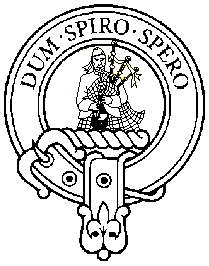
Clan MacLennan

Clan MacLennan
After raiding Tain and Chanonry in 1372 the Clan was defeated by the Frasers and MacRaes of Aird at Drumderfit, Black Isle. The sept name Lobban originated from this battle. A further reverse at Lagabraad Conon in 1481 of Chief Duncan and his Clan terminated the MacDonald association. The name Logan is from the Gaelic word Laggan, meaning low lying ground, and this sept provided the Knights Sir Robert and Sir Walter Logan who escorted King Robert the Bruce's heart to the Holy Land. Both died with Sir James Douglas fighting the Moors in Spain in 1329.
At an early date they held lands in Strathearn, Galloway, Ulster and later were Barons occupying Restalrig and Fast Castles. Geoffrey, son of Knight Logan c1150 took the name of his estate GASK from whom those of the name Gass descend. Duncan MacLennan of Strathearn, who is mentioned in the charter of Alexander II in 1217, became Laird of Bombie. This spelling over a period of time became MacLellan and there were no fewer than 14 Knights in Galloway at the beginning of the 15th Century.
The religious strife in Scotland and Ireland brought the Clan together. Chief Ruairidh Ban, Son of John MacGillafinnen, was in Holland around 1630 in connection with the flight of the Earls from Ireland. At the Battle of Auldearn in 1645, the Clan (Scottish, Irish and Logans) failed to receive the order to retreat; were isolated and cut down by the Duke Gordon's Cavalry; eighteen Captains of the Clan were killed; and brothers of the Chief (Donald and Duncan MacIan) died defending the Standard. In recognition of the outstanding bravery of gigantic red-haired Chief Rory Ban, he was offered an honourable surrender; however, he declined and was shot. As Bothwell observed, the MacRaes married the widows and became a considerable Clan. A hundred years later at the Battle of Culloden, only twelve of the Clan took part, including Roderick (grandson of Chief Rory), so the great losses at Auldearn were still obvious.
Emigration to seek betterment in places throughout the world saw further disbandment of the Clan. However, the embers of pride in our heritage still glow as Chief Ruairidh Donald George MacLennan of MacLennan, the 35th Hereditary Chief of Clan MacLennan, enthusiastically leads the Clan, and along with his sisters Kirsteen and Lorna, ensures the continuation and grace of our evergreen line.
 The Gathering of the Clans
The Gathering of the Clans

The MacLennans/Logans consist of two distinct families; one belonging to the Highlands and the other to the Lowlands. However, as far as it is known, there is no historical evidence to connect the two families. The Logans of the south held Restalrig near Edinburgh and it was Sir Robert of that Ilk
who married a daughter of Robert II and was made Admiral of Scotland in 1400. But even before then two knights of the name were recorded as companions of Sir James Douglas carrying Bruce's heart to the Holy Land. However the Logans did not remain in favour and the last Logan of Restalrig died an outlaw
and the family became extinct. The Highland Lobans or Logans, "Siol Ghillinnein" (MacLennan), according to tradition descend from Logan of Drumderfit in Easter Ross. Their legendary leader Gilligorm in a feud with the Frasers was killed in a sanguiary battle at North Kessock between the two clans. The widow of Gilligorm was carried off by the Frasers and later gave birth to a deformed child who was named Crotair Mac Gilligorm (the hump-backed). He was educated by the monks at Beauly and later joined the church. He founded the churches of Kilmor in Skye and Kilchrinin in Glenelg. His son was named Gille Fhinnein, "The Devotee of St. Finnan" of which the Anglicized form is Maclennan. The Logans of Drumderfit were still in Easter Ross in the early 18th century, and in Wester Ross they lived
neighbouring the Macraes and were followers of the Mackenzies of Kintail for whom they were Standard Bearers. James Logan was the famous author of the "Scottish Gael" (1831) which was a record of the Highlands and the first serious attempt to record the history of Highland dress. The present chief was 12 years old when, in 1989, he succeeded his father as the 35th chief of Clan MacLennan. He was also the head chorister at St. Andrew's Episcopal Cathedral, Inverness.
 Electric Scotland
Electric ScotlandI owe a debt of gratitude to Alistair McIntrye, WebMaster of Electric Scotland, for his generosity in allowing me to use some of the marvelous information from his site for this page.
